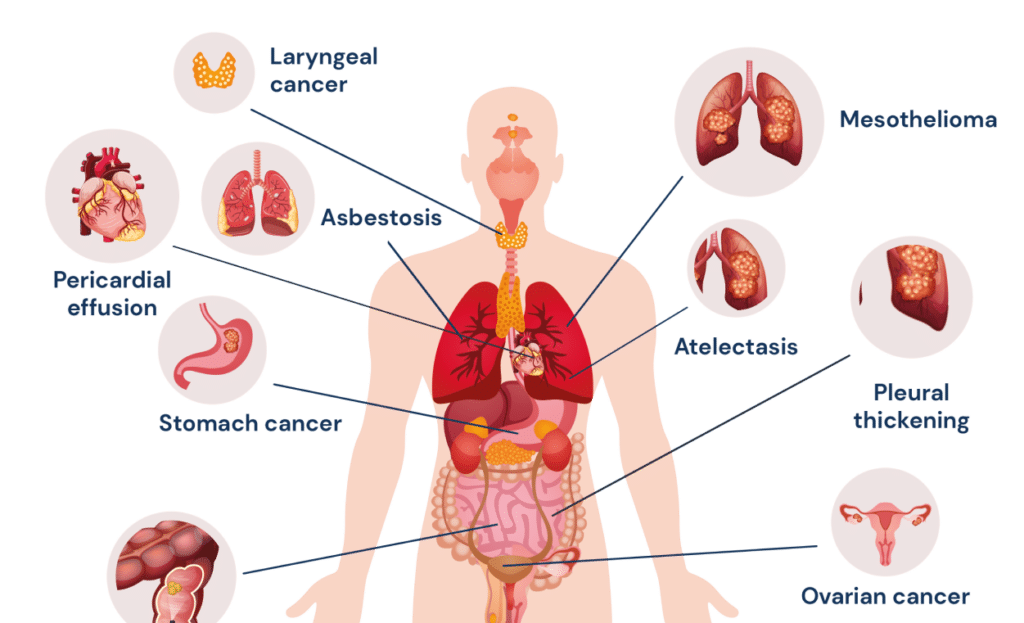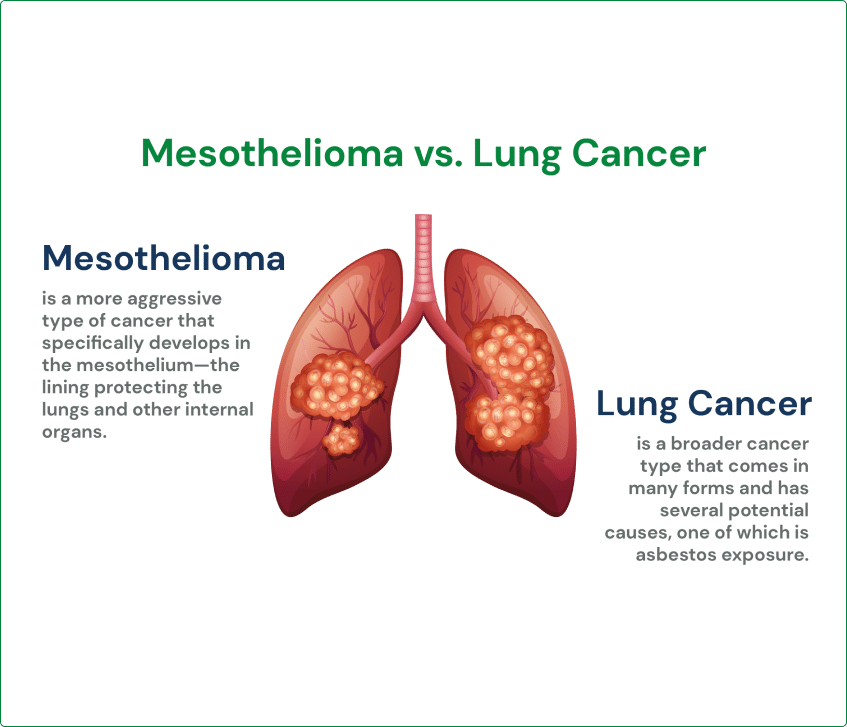Asbestos Lung Cancer
Asbestos lung cancer is a major concern for many trade workers because of the mineral’s use as an insulator in common equipment and materials in construction and metal work. A lung cancer diagnosis after years of work in a trade in the Pacific Northwest could have resulted from asbestos exposure, entitling you to compensation. Bergman Oslund Udo Little is Oregon and Washington’s premier plaintiff’s law firm for victims of occupational asbestos exposure.
Chandler H. Udo, Partner, Bergman Oslund Udo Little Last Updated: January 23, 2025

Asbestos and Lung Cancer
Asbestos is a mineral found naturally in rock. People and businesses heavily mined the product leading up to and during the Industrial Revolution because of its benefits in numerous trades. It was widely used as an insulator in products and materials until the 1980s. The toxic material is still present in older materials and sites and is still used in limited circumstances. The low cost and high heat resistance made it an efficient product in manufacturing equipment, construction materials, and many other uses that made exposure common.
Lung cancer is one of the main risks of repeated exposure to large quantities of asbestos. The lungs are the most common body part for developing asbestos-related medical conditions because of how the fibers enter the body.
The Centers for Disease Control estimates that anywhere from four to twelve percent of lung cancers result from occupational asbestos exposure, and about a quarter of all asbestos-exposed workers develop lung carcinomas. The potential of this risk of lung cancer can vary based on different factors, such as the following:
- The frequency, duration, and amount of exposure
- Your age when the exposure happened and the time elapsed since
- History of smoking
- Other traits that increase the risk factors for lung cancer, such as family history
Ultimately, the greater your level of asbestos exposure through your work at a manufacturing facility, industrial plant, or trade, the higher your chances of developing lung cancer. An asbestos exposure lawyer can help determine the exposure level and how it could entitle you to compensation claims.
How Does Asbestos Cause Lung Cancer?
Asbestos causes lung cancer when its tiny fibers enter the respiratory system through inhalation. It’s also possible for asbestos exposure to occur through skin contact or ingestion, but inhalation is the most common means of exposure. Even the smallest disruption of a material can release asbestos fibers into the air, where they can be inhaled.
Once inhaled, removing asbestos fibers is impossible, and they can become trapped in the lung tissue, going largely unnoticed for an extended time. Eventually, the asbestos fibers can cause cancerous cells to develop within the lung tissue. While lung cancer is one outcome of asbestos exposure, you could also develop other diseases, including the following medical conditions:

- Mesothelioma
- Asbestosis
- Laryngeal cancer
- Stomach cancer
- Ovarian cancer
- Colon cancer
- Pericardial effusion
- Atelectasis
- Pleural thickening
Some of these conditions are more serious than others and can have varying impacts on your life and health. When symptoms of asbestos-related conditions occur, it’s essential to seek immediate medical evaluation for proper diagnosis and treatment options.
Lung Cancer Caused by Smoking
While asbestos lung cancer is common, it’s also possible to develop lung cancer through exposure to other dangerous toxins and chemicals. Most notable are the carcinogens inhaled through smoking cigarettes, cigars, and other forms of tobacco and drugs. Even if you don’t personally smoke, you could still have a risk of cancer through second-hand smoke, which occurs through frequent proximity to others smoking for extended periods. The Centers for Disease Control suggests lung cancer is linked to smoking in 80 to 90 percent of cases, resulting in death, and smokers are 15 to 30 times more likely to have lung cancer compared to non-smokers.
Combining asbestos exposure with smoking could put you at a greater risk of getting lung cancer compared to only having one risk factor. Unfortunately, smoking was not uncommon among trade workers who were often exposed to asbestos or inhaled asbestos while at work, which can make related claims for personal injury and wrongful death more complicated. The challenge is apportioning the weight of these factors in causing your lung cancer diagnosis.
Types of Lung Cancer
Lung cancer from asbestos exposure primarily comes in two different forms. The first is small cell lung cancer, which gets its name from the shape and size of the cells. Small cell lung cancer has a faster growth rate, and chemotherapy is often the recommended treatment for that reason. It also has a strong link to cigarette smoking.
The more common type of asbestos lung cancer, however, is non-small cell lung cancer and accounts for approximately 80 to 85 percent of all lung cancer diagnoses. This form of lung cancer comes in many different subtypes, such as large cell or squamous cell cancer.



Mesothelioma vs. Lung Cancer
When learning about the cancerous effects of asbestos exposure, you’ll likely hear about both lung cancer and mesothelioma, another type of cancer found in the lungs. The two have similarities but have distinct properties with unique treatments and prognoses. While both types of cancer come from asbestos exposure and occur in the lungs, there are key differences.
Mesothelioma is a more aggressive type of cancer that specifically develops in the mesothelium—the lining protecting the lungs and other internal organs. Asbestos exposure is the only known cause of malignant mesothelioma. In contrast, lung cancer is a broader cancer type that comes in many forms and has several potential causes, one of which is asbestos exposure.
Lung Cancer Symptoms and Diagnosis
Most symptoms of lung cancer relate to the lungs and your overall respiratory system. If you develop the following signs, seek medical attention, especially when they occur simultaneously:







The most common and initial method of diagnosis for lung cancer is a CT scan to identify any abnormalities in the lung tissue from cancerous cells. From there, a doctor may perform a biopsy or other testing to confirm the diagnosis.
Treatment
Options
The treatment for lung cancer will depend on the professional recommendation of a doctor from a qualified treatment center. However, the treatment options will generally include a combination of chemotherapy, radiation, or surgery to remove cancerous tumors. The success and risk of these options could depend on factors like medical history, age, and the stage of the cancer’s progress.
Prognosis and Survival Rates
The prognosis and survival rate for asbestos-related lung cancer will depend on the type and individual health factors. Current data from the American Cancer Society shows that 5-year survival rates are better for non-small cell lung cancer than small cell lung cancer and can vary based on how far the cancer has spread, with more localized lung cancer having a greater survival rate.
How Do Doctors Link Lung Cancer to Asbestos?
Doctors often use the Helsinki Criteria as a method of connecting a lung cancer diagnosis to exposure to asbestos products. This method looks at several factors and markers, including the following:
- The cumulative exposure is 25 fiber-years or greater.
- The frequency and duration of occupational exposure, with the risk higher from one year of heavy exposure or at least 5-10 years of moderate exposure
- The latency between the exposure and the diagnosis
Most asbestos lung cancers have a latency period of 20 to 30 years between their exposure and the presentation of symptoms associated with lung cancer.
Asbestos Lung Cancer FAQs
If you or a loved one has recently been diagnosed with lung cancer from asbestos exposure, you undoubtedly have many questions. Here are some answers:
What’s the Difference Between Mesothelioma and
Asbestos Lung Cancer?
Asbestos Lung Cancer?
Both mesothelioma and lung cancer can result from asbestos exposure. Mesothelioma is a cancer that affects the lining of internal organs such as the lungs, abdomen, testes, or heart. Mesothelioma in the lining of the lung is called pleural mesothelioma. Asbestos lung cancer is a different type of cancer that originates in the lung.
Does Everyone Exposed to Asbestos
Develop Cancer?
Develop Cancer?
Exposure to asbestos doesn’t necessarily mean that one will develop lung cancer or mesothelioma. However, it certainly increases the risk of contracting either disease. If you’re worried about the possibility of developing lung cancer or mesothelioma due to your asbestos exposure, it’s important to discuss your concerns and history of exposure with a doctor.
Am I Eligible for Compensation for My Asbestos-
Related Lung Cancer?
Related Lung Cancer?
If you or a loved one has been diagnosed with lung cancer due to asbestos exposure, you may be entitled to compensation. Contact our Washington and Oregon asbestos lawyers today to learn about your rights.
Does a History of Smoking Affect My Case?
When pursuing legal action, you must establish that asbestos exposure caused your lung cancer. Smoking can complicate matters, as it is also a known cause of lung cancer. Your ability to receive compensation often relies on proving that asbestos exposure was a significant contributing factor to your condition.
Legal Options for Asbestos-Related Lung Cancer
If you were an industrial worker in the mid to late 1900s at a paper plant, steel mill, or another manufacturing facility, your lung cancer may be the result of asbestos exposure on the job in Washington or Oregon. You may be eligible to pursue a civil claim for compensation against the manufacturers, distributors, contractors, and others responsible for your exposure who failed to remove asbestos from the work environment.
The attorneys at Bergman Oslund Udo Little exclusively work on asbestos-exposure matters, including claims from cases of lung cancer. Since 1995, our firm has fought for the legal rights of individuals and their families in seeking justice from those who knowingly and wrongfully exposed workers to asbestos. We are proud of our efforts in these matters, which have resulted in the collection of over $1 billion for our clients.
Contact Bergman Oslund Udo Little for a free mesothelioma and lung cancer case review.



